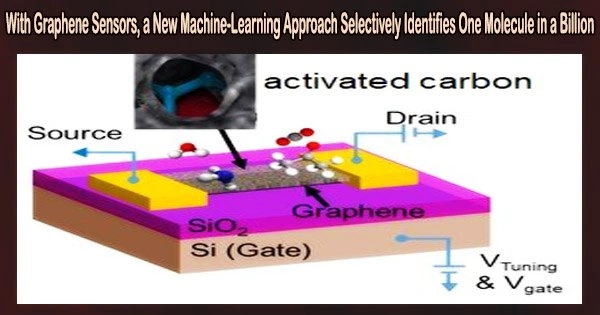The 2D structure of graphene, its single molecule sensitivity, low noise, and high carrier concentration have sparked a lot of interest in its use as gas sensors. However, because of its inherent non-selectivity and high p-doping in atmospheric air, its applications in gas sensing are frequently restricted to controlled environments such as nitrogen, dry air, or synthetic humid air.
While humidity conditions in synthetic air can be used to achieve controlled hole doping of the graphene channel, this does not adequately replicate the situation in atmospheric air. Furthermore, atmospheric air contains a number of gases with concentrations comparable to or greater than the analytic gas.
Such graphene-based sensor inadequacies impede selective gas detection and molecular species identification in ambient air, which is essential for applications such as environmental monitoring and non-invasive medical diagnosis.
The research team led by Dr. Manoharan Muruganathan (formerly Senior Lecturer), and Professor Hiroshi Mizuta at the Japan Advanced Institute of Science and Technology (JAIST) employed the machine learning (ML) models trained on various gas adsorption-induced doping and scattering signals to realize both highly sensitive and selective gas sensing with a single device.
The conventional graphene-based ML models are limited in their input features.
Dr. Osazuwa Gabriel Agbonlahor
The ML models’ performances are often dependent on the input features. “The conventional graphene-based ML models are limited in their input features,” says Dr. Osazuwa Gabriel Agbonlahor (formerly post-doctoral research fellow).
The previous ML models solely monitor the changes in graphene transfer properties or resistance/conductivity caused by gas adsorption without manipulating these characteristics with an external electric field.
Hence, they miss distinctive van der Waals (vdW) interaction between gas molecules and graphene, which is unique to individual gas molecules. As a result, unlike traditional electronic nose (e-nose) models, we can map the external electric field modulated graphene-gas interaction, allowing for more selective feature extraction in complex gas environments like ambient air.
Our ML models for identifying atmospheric gases were created using a graphene sensor that had been functionalized with a porous activated carbon thin layer. Eight vdW complex characteristics were employed to monitor the impacts of the external electric field on the graphene-gas molecule vdW interaction, and thus map the evolution of the vdW bonding before, during, and after the application of the external electric field.
Furthermore, despite the fact that the gas sensing experiments were carried out under a variety of experimental conditions, such as gas chamber pressures, gas concentrations, ambient temperature, atmospheric relative humidity, tuning time, and tuning voltage, the developed models were shown to be robust enough to account for these variations in experimental conditions by not exposing the models to these parameters.
Furthermore, to test the models’ versatility, they were trained in both atmospheric and relatively inert environments commonly used in gas sensing, such as nitrogen and dry air.
As a result, a high-performance atmospheric gas “electronic nose” was developed, capable of accurately discriminating between four different environments (ammonia in atmospheric air, acetone in atmospheric air, acetone in nitrogen, and ammonia in dry air).
















